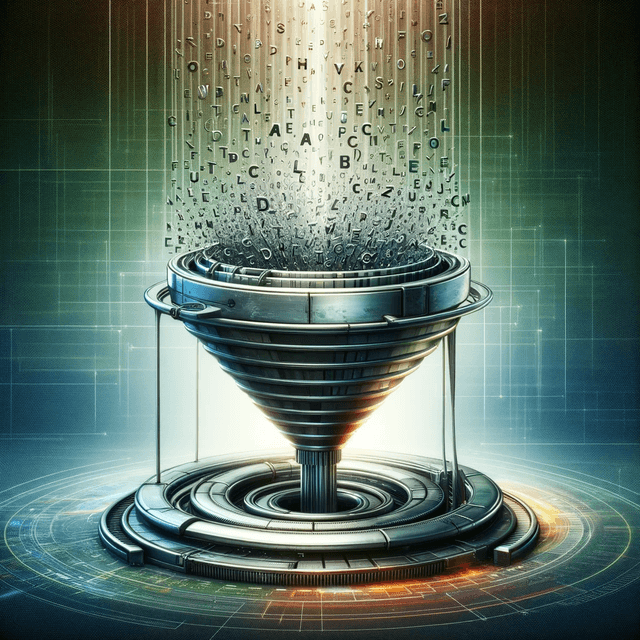
Hook Generator
Uncover the art of writing hooks, headlines, and intros that demand attention from your readers.
Instructions
- Briefly describe what you are trying to write a hook for. An essay intro, an ad headline, selling a product, etc.
- Press "Generate" and Typli will write some attention grabbing hooks for you.
Try more AI writing tools
There's 112 to choose from.

AI Text Generator
Unleash the power of AI to generate creative and engaging text with Typli's Free AI Text Generator.

AI Paraphrasing Tool
Looking for a reliable paraphrasing tool? Check out our AI-powered solution.

AI Summarizer Tool
Get to the point with our efficient AI summarizer tool.

AI Acronym Generator
Get personalized and original acronyms in seconds with our user-friendly generator tool that's perfect for all your needs.

AI Letter Generator & Writer
Quickly create professional or informal letters using our AI letter generator tool.

Passive to Active Voice Converter
Easily convert passive voice to active voice for a more impactful and engaging writing style.

Bullet Point Generator
Turn your ideas into clear, concise bullet points. Perfect for presentations, lists, and summaries.

AI Image Generator
Generate unique high quality AI images quickly.

AI Speech Writer
Create compelling speeches with our AI speech writer — a tool to craft messages that resonate, from informative and persuasive to motivational and entertaining.

ChatGPT Rewriter
Transform your text with ChatGPT Rewriter - the ultimate tool for rephrasing and paraphrasing content.

Quote Generator
Generate compelling and impactful quotes with the help of our AI quote generator. Save time and stay inspired.

Sentence Rewriter
Transform your content with our AI sentence rewriter and create fresh, unique text.

AI Writing Generator
Unleash the power of artificial intelligence to generate high-quality, engaging content with Typli's Free AI Writing Generator. Ideal for bloggers, marketers, and content creators.

AI Content Generator
Generate compelling, unique content instantly with Typli's Free AI Content Generator. Perfect for blogs, social media, and marketing material.

AI Headline Generator
Instantly generate eye-catching headlines with Typli's Free AI Headline Generator. Perfect for articles, blogs, and marketing campaigns.

Project Name Generator
Generate a creative and unique name for your project. Get name ideas that capture the essence and goals of your project.

Paragraph Rewriter
Produce authentic and captivating content by rewording paragraphs with our rewriter tool.

Paragraph Generator
Typli’s AI paragraph generator crafts sentences that flow like a river, delivering smooth, relevant, and surprisingly human paragraphs that get better with each use.

AI Word Expander
Add depth and creativity to your writing with our AI word expander tool for a more sophisticated language experience.

Hook Generator
Uncover the art of writing hooks, headlines, and intros that demand attention from your readers.
The Art of Crafting Attention-Grabbing Hooks, Headlines, and Intros
You only have a few seconds to capture your reader’s attention. Writing compelling hooks, headlines, and intros is crucial to engage your audience right from the start. But how do you craft these attention-grabbing elements? Let’s delve into the art of creating them effectively and ensuring that your content leaves a lasting impression.
Understanding Attention-Grabbing Hooks
Have you ever been completely hooked by the first line of a story? That’s the magic of a great hook—it snags your interest and reels you in. Hooks play a big role in making you want to dive deeper into an article, a book, or even a social media post. It’s like the key to a treasure chest; get it right, and you unlock your reader’s curiosity and attention. Let’s unlock the secrets to creating hooks that are impossible to ignore.
The Role of a Hook in Capturing Attention
Imagine your reader is like a fish swimming in a sea of words, and you’ve got just one shot to lure them in with your best bait. That’s where a strong hook comes into play. It’s the shiny, wriggling worm at the end of your line – the initial sentence or question in your piece that snaps up the reader’s curiosity and doesn’t let go.
Think of it as the first impression. You want it to be memorable enough to keep the reader hooked. Whether it’s a surprising fact, a thought-provoking question, or a powerful statement, it should spark a reaction . This emotional or intellectual tug is crucial because when readers bite, they’re more likely to stick around for the whole story.
Types of Hooks and Tips for Effective Usage
Grabbing your audience’s attention right off the bat can make a huge difference in whether they stick around or not. The trick is to reel them in with a strong hook. There are many types of hooks you can use, each with its own way of drawing readers in.
Storytelling Hooks
Imagine beginning your piece with a brief, captivating story. This draws readers into a narrative they want to follow to the end. Just make sure it’s relevant and gets straight to the point.
Question Hooks
Invite readers to ponder by starting with a thought-provoking question. This engages their curiosity and encourages them to read on for answers. Keep the question open-ended and relatable, so they’re compelled to think.
Statistic Hooks
Nothing says ‘pay attention’ like a jaw-dropping statistic. This hook offers hard-hitting data that can surprise readers and create a thirst to learn more. Opt for recent and credible numbers to back up your claims.
Quotation Hooks
Pulling in a powerful quote from a well-known figure can lend authority to your piece. Choose quotes that resonate with your topic and stir emotion or debate.
Descriptive Hooks
Set the scene with vivid descriptions to captivate the reader’s senses. Paint a picture that’s hard to look away from, and they’ll want to stick around for the full view.
To use these hooks effectively, remember to tailor them to your target audience and the message you want to convey. Match the style of your hook to the tone of your content, ensuring a seamless transition that respects your reader’s expectations. A little creativity here goes a long way—strike with something unforgettable, and your readers will hang onto every word.
Crafting Intriguing Headlines
Imagine a world where headlines don’t just sit there but leap off the page and pull you in. That’s the kind of magnetic pull you want your headlines to have. They’re not just the sign on the door; they’re the alluring aroma that draws readers into the feast of your content. Headlines that stand out don’t just happen—they’re carefully chiseled and polished to perfection. Let’s explore the secrets of turning words into reader magnets. 🧲✨
The Anatomy of a Captivating Headline
Picturing the perfect headline is a bit like imagining the ideal bait for a hungry fish. It’s gotta be just right —enticing enough to catch the eye, and promising enough to snap up without a second thought. A headline worth its salt is a delicate blend of curiosity , clarity , and a touch of creativity .
Imagine your headline as the beating heart of your content. The best ones often include a power-packed combo of strong keywords that hit the sweet spot of what your audience craves, numbers that offer concrete value, and an emotional appeal that makes the heart race a little faster. It’s not about filling space, it’s about creating an irresistible urge to dive deeper into what lies beneath the headline. Keep it snappy, make it snazzy, and above all, make sure it stays true to the goldmine of information you’re about to unleash on the reader.
Best Practices for Writing Engaging Headlines
Crafting a headline that stands out is like serving the perfect appetizer - it’s got to be delicious enough to make your readers crave the rest of the meal. Keep it short and snappy; a long headline can lose your audience before they even begin. Aim for a sweet spot around 6 to 8 words. Think of it as a Twitter post; you have limited space to make a big impact.
Something else to remember: hit an emotional chord . Whether it stirs curiosity, excitement, or even controversy, an emotionally charged headline can make the difference between scrolling by and clicking through. But be honest - don’t promise what your content doesn’t deliver. Misleading headlines can hurt credibility and bounce rates. To get it right, brainstorm multiple headlines and test them to see which one fires up your readers’ interest the most.
Mastering Compelling Intros
Nailing the intro of your article is like acing the opening moves in a game of chess – it can determine the game’s outcome. From the get-go, a well-crafted intro sets the stage and reels in the reader, promising them value and insight in exchange for their time. Getting this right means you’re not just saying hello, you’re inviting your audience onto an intriguing journey that they just can’t resist.
Setting the Tone and Baiting the Reader
Imagine you’re setting the scene for an epic movie. The first few scenes are crucial—they decide whether the audience sticks around for the rest of the show. That’s what the opening lines of your piece do for your reader. Setting the tone means giving your audience a taste of what’s to come, much like an appetizer before a feast.
Once you’ve got the tone right—be it curious, urgent, or playful—it’s time to lay down a trap for their attention. Baiting the reader is like setting a hook: you dangle an intriguing fact, a challenging question, or a compelling story. The key here is to craft a bait that’s too enticing to ignore, leading your reader deeper into your content, eager for every next word.
Creating a Connection with the Audience
Creating that special bond with your audience is like starting a friendship; it begins with showing that you get them. By weaving personal stories or relatable anecdotes into your intros, you instantly build a bridge of familiarity. It’s important to remember, nobody wants to be just another face in the crowd. So, when you address readers as if you’re chatting with a friend, they feel seen and heard.
Including questions can also be a powerful strategy. Ask something that provokes thought or a nod of agreement. Questions can act like a virtual hand-raise, inviting your audience into a conversation instead of just hitting them with a wall of text. This kind of engagement turns passive readers into active participants, glued to every word you write.
Conclusion
Mastering the art of writing effective attention-grabbing hooks, headlines, and intros is the gateway to captivating and retaining your audience. Each element serves as the gateway to magnetize readers into exploring your content further. With practice and a good understanding of your audience, you can elevate your content to new heights of engagement and impact.